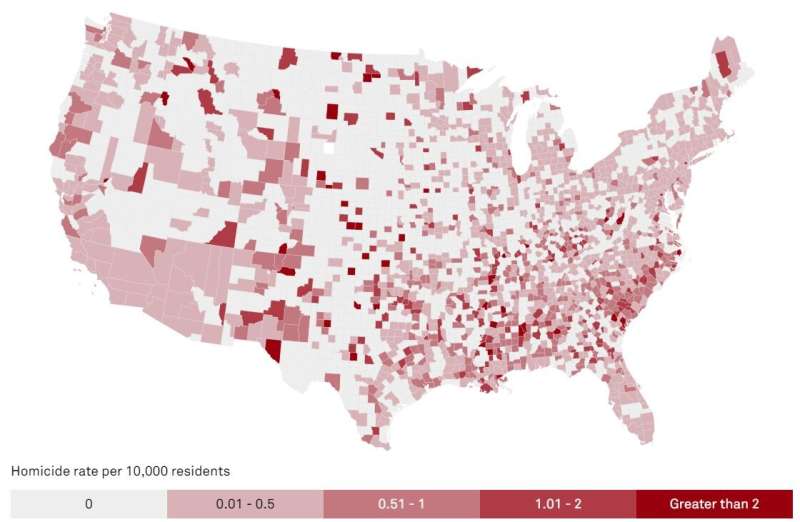Can gun violence be traced back to socioeconomic root causes?

Life expectancy in the U.S. has dropped as a result of gun violence, says Daniel Kim, an associate professor of health sciences at Northeastern.
Despite the critical need for studies that address the underlying causes of gun violence, he says, no comprehensive study has looked at the various factors behind this crisis.
In a recent study, Kim provides new insight into how different social and economic circumstances could be driving gun violence in the U.S.
The study focuses on socioeconomic status, income inequality, and other similar aspects known as the social determinants of health, and analyzed 13,060 gun deaths in all states of the contiguous U.S.
Kim found that the strongest association was between gun homicides and social mobility, or the ability of people to move to a higher social status than that of their parents.
He discussed how his research can be used to influence policy and address trends of gun violence in the U.S.
Until now there hasn't been a comprehensive study that links the relationship of societal and economic conditions with gun violence in the U.S. Why is undertaking such a study important?
Gun violence has reached epidemic proportions in the U.S. and is a public health crisis. On average, an estimated 100 people in the U.S. are killed with guns every day. Between 2001 and 2013, firearm injuries took more U.S. lives than the combined number of U.S. people killed by war, AIDS, illegal drug overdoses, and terrorism.
Evidence on the impacts of gun control policies is growing, but there is a fundamental need to better understand the root social causes of gun violence and homicides. So far, there have only been a limited number of studies on this topic, and the methods used in these studies have fallen short to varying degrees. For example, gun homicide studies have primarily focused on one social determinant and one geographic level at a time, which can give us biased answers.
In my study, I looked at a wide range of major social determinants of health—social conditions that have been linked to mortality and many other health outcomes. I controlled for multiple social determinants at the same time, and incorporated a range of other factors at the neighborhood level. Using this comprehensive approach enables us to obtain better estimates of the true relationship between any given factor and gun homicides.
Your study analyzes such factors as disparity in income, trust in the government, social mobility, and public welfare in the U.S. How exactly are these conditions associated with gun homicides?
My study found that an increase in average levels of intergenerational social mobility—our ability to climb the economic ladder compared to our parents—was linked to a 25% decrease in neighborhood gun homicide rates. Higher levels of trust in institutions such as the government, media, and corporations were associated with a 19% lower neighborhood gun homicide rate. Meanwhile, higher levels of public welfare spending were related to a 14% lower neighborhood homicide rate, while the rich-poor gap was related to an 8% higher neighborhood homicide rate.
I did not explore why each of these factors might have an effect on gun homicides. Nonetheless, there are plausible hypotheses that support each of these relationships. For example, in communities that have low levels of trust in institutions, such as the police, people may choose to take the law into their own hands, and resort to criminal behaviors, including homicide. Future studies would be helpful in further exploring these mechanisms.
How can your research into socioeconomic conditions and gun violence help address recent declines in life expectancy in the U.S.?
We know that gun homicides are the second leading cause of injury death among youths and young adults. This and other statistics about gun violence in the U.S. are quite sobering and worrisome alone.
These deaths can have a sizable impact on average life expectancy, which in the U.S. has been in decline for three consecutive years for the first time in a century. By identifying and addressing the root social causes of gun homicides, we have the ability to help reverse these alarming trends in America.
What do your findings tell us about policies that could help address the problem of gun violence?
While the findings of this study do not establish cause and effect relationships, the intriguing relationships that I found suggest some key social drivers of the gun violence epidemic. These social determinants are things that can be modified through social and economic policies.
For instance, policies that make college more affordable to people from lower income backgrounds could raise levels of social mobility. Levels of income inequality could also be reduced through policies that raise taxes on the rich—something that I have explored previously in my research. Tax policies that further redistribute income to low-income households could additionally reduce poverty, which in my study was associated with a 27% higher neighborhood gun homicide rate.
These examples of social and economic policies are being discussed on the debate stage of the U.S. presidential race, independently from the topic of gun violence. Ultimately, being able to connect the dots between gun violence and such policies could be an effective way to help tackle the gun violence epidemic.
Provided by Northeastern University



















